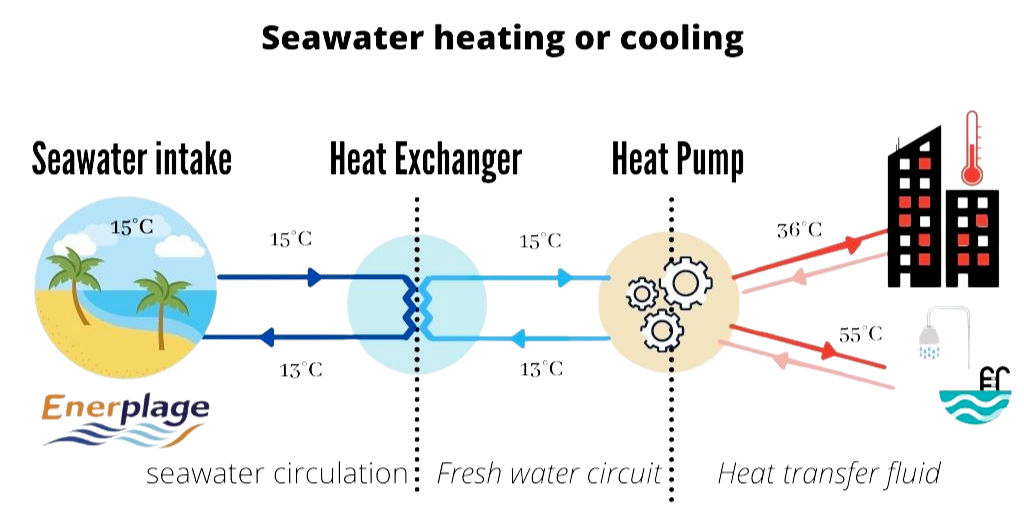Marine Geothermal Energy
The Enerplage system®
One of the major challenges of this decade is to meet the growing energy needs accentuated by population growth while making sure we do not accelerate the effects of global warming.
Sustainable development is "development that meets the needs of the present without compromising the ability of future generations to meet theirs" (quote from Ms Gro Harlem Brundtland, Prime Minister of Norway, 1987).
Coastlines are a strong attraction for people around the world. Today, 60% of the world's population lives within 150 km from the shore (IUCN). In the future, more and more people will live on the coast, so energy needs will naturally increase. However, we now know that the ocean is full of available energy in different forms: wind, currents, waves, tides etc. These resources make it possible to meet a large part of the energy needs present on the coast by exploiting its potential.
One of these sources of marine energy is the exchange of calories with seawater.
Our technology is similar to SWAC systems (Sea Water Air Conditioning). However, a SWAC system uses deep cold water in the sea to cool buildings. However, our Enerplage® system can heat and/or cool buildings on the shoreline by using a heat pump. This system can be used for hotels, spas, swimming pools or residences.
How Does It Work?
Seawater is pumped and goes through heat exchangers where calories are transported to a freshwater network. Seawater is then returned to its natural environment a little colder or warmer depending on the use. Seawater discharge does not compromise biodiversity as it is quickly diluted. The freshwater takes the calories of seawater to the heat pump (water/water type) and it will convert these calories into heat or cold depending on the needs of the infrastructure.
The use of this marine geothermal energy reduces heating and air conditioning costs while also reducing greenhouse gas emissions (up to 80% compared to fuel oil). Seawater is also a local, available and renewable resource. This model offers technical, ecological and economic benefits.
For optimal efficiency, seawater must be filtered enough in order to avoid clogging problems on the exchangers, the pipelines and the seawater intake.

Thanks to its drainage system, Enerplage® technology can solve this issue. The system uses the natural filtering capacity of beach sand by burying the drains. Seawater will then be filtered in those drains continuously to produce naturally and highly filtered seawater. This method does not require more filters and also saves investment and maintenance costs unlike other seawater intakes.
The system uses the natural filtering capacity of beach sand by burying drains in the sand. Seawater will then be filtered in those drains continuously to produce naturally and highly filtered seawater. This method does not require more filters and also saves investment and maintenance costs unlike other seawater intakes.
The Enerplage® seawater intake is implemented on the beach which means there is no need for underwater work. The water supply still remains continuous because the system is deep enough to collect seawater even during low tides.
The Enerplage® system offers highly filtered seawater, ideal for the use of a heat pump. It will reduce costs associated with maintenance and filters, compared to other more classical methods of seawater intake. These installations can save up to 75% of energy and reduce greenhouse gas emissions. The Coefficient of Performance (COP) of a heat pump for geothermal marine energy is generally greater than 4. That is to say that for 1 KW used to operate a heat pump; it is possible to produce 4kW.
ECOPLAGE has implemented three Enerplage® systems that use seawater as a way to heat and cool buildings or pools. A first pilot system was carried out in Saint-Gilles-Croix-de-Vie during the summer of 2013. The aim of this experiment proved the feasibility of coupling a drainage system and a heat pump. Since then, the technology has been installed in La Baule-Escoublac at the Aquabaule Aquatic Center (read more here), and also at the Sea Spa Center Rivage (read more here). There is also a system on the beach of Saint-Jean-de-Luz to meet the energy needs and provide water to the Spa Center Thalazur.
As a bonus, the Enerplage® system will slow erosion on the beach with no negative impact.
